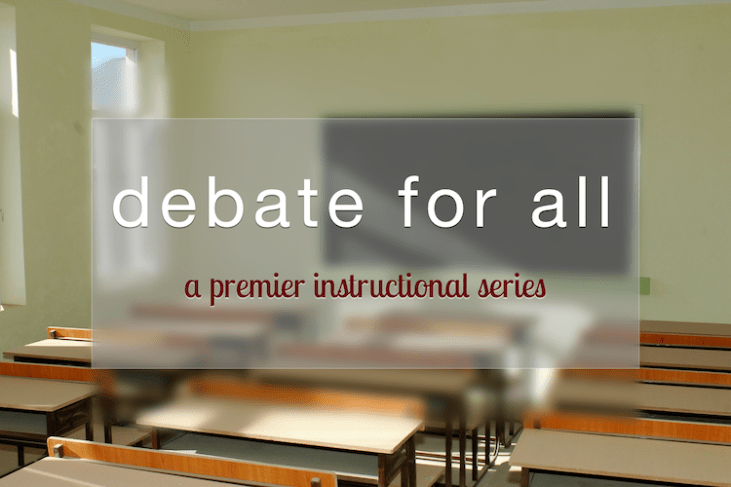Lincoln-Douglas Debate, explained

Author’s Note: While most of our readers are intimately familiar with Lincoln-Douglas debate, this article is part of an effort to promote outreach. We are hoping this article can help introduce new students, teachers, school administrators, parents, etc. to Lincoln-Douglas debate.
What is Lincoln-Douglas debate?
Lincoln-Douglas is one of several prominent formats for competitive high school debate in the United States. In Lincoln-Douglas debate, students face off in one-on-one debates on a variety of topics. Before the round, each debater is assigned to either support or refute the given resolution. The format provides specific speech times for both the affirmative and negative debaters as well as a limited amount of time to review and prepare their notes during the debate. A single round of Lincoln-Douglas debate usually lasts between 45 – 60 minutes, and tournaments usually have three to six preliminary rounds. After preliminary rounds, top performers are ranked according to their wins and ‘speaker points’ and then proceed in a single-elimination bracket until there is a champion.
Topic resolutions rotate on a two-month cycle, and students spend weeks researching and preparing arguments on both sides. Pre-written arguments fall into two categories. Initial arguments (called “constructives”) are synthesized into cases. These are read in the first speeches of the debate and set up the core arguments that will decide the round. Other pre-written arguments are designed only as a response to an opponent’s arguments and are called blocks or frontlines. These are usually read in the later speeches where debaters are focused on rebutting their opponent’s arguments. Additionally, debaters will make rebuttal arguments extemporaneously if none of their pre-written blocks apply.
Why is it called “Lincoln-Douglas”?
Lincoln-Douglas debate is named for a famous series of debates held in Illinois in 1858. As part of the Illinois Senate election being held that year, Republican Abraham Lincoln faced off against incumbent Democrat Stephen Douglas. Despite Illinois being a free state, the principal topic of the debates was slavery, specifically whether new territories and states ought to allow slavery. While Lincoln would go on to lose the Senate race, the debates helped launch him on to the national stage and were a major factor in his election to the presidency two years later. Over 100 years later, when Lincoln-Douglas debate was being created on the high school level, it’s designers wanted the debates to center on issues of values, logic, and morality; the same core themes that were called upon in Lincoln’s debates in 1858.
What do students learn in Lincoln-Douglas debate?
Lincoln-Douglas debate teaches students rigorous research and writing skills. A large part of success in debate is the preparation that occurs before speaking even begins. Students then gain experience presenting complicated ideas in clear and effective presentations, communication skills that will benefit them far beyond debate. Additionally, they learn details about a lot of important topics. From gun control to U.S. foreign aid, nuclear power to free speech on college campuses, students dive into the issues and become experts on arguments both for and against. This process teaches critical thinking and how to analyze a problem from both sides.
What exactly do they debate?
Every year the National Speech and Debate Association, which governs high school forensics, issues a list of potential topics. These cover a wide variety of controversies ranging from foreign and domestic policy to philosophical and moral issues. Current students and coaches then get to vote on the topics, and the most popular are selected for the following debate season. Once the topic is announced, debaters across the country start the long process of researching the topic. While debaters may have personal convictions on the topic, they’ll be forced to argue both for and against the resolution and will need to be familiar with the research on both sides. A comprehensive list of former topics can be found here***.
Why do some debaters talk very quickly?
A common practice at some debate tournaments is speed reading, or “spreading.” While originally an uncommon practice in Lincoln-Douglas, spreading has become more common since 2000, especially at large national tournaments. Since debaters have limited time to make arguments, there is an incentive to speak faster to fit more arguments into a speech. While many judges take no issue with this, certain judges prefer debaters to talk at a conversational place. These more traditional judges also put more focus on the presentation of arguments, rather than just the content. Despite spreading’s prominence at some of the largest national tournaments, most local tournaments feature few instances of spreading and many talented debaters go their entire careers without encountering or being required to spread.
What is “traditional” and “circuit” debate?
While every debater’s individual style is different, they can largely be grouped into two camps, traditional and circuit debate. Traditional Lincoln-Douglas debates value formal presentation, do not feature spreading, and often focus on abstract philosophical issues, rather than the details of specific policies. Circuit Lincoln-Douglas debate (named for the so-called “national circuit”) features spreading, high-speed analytical arguments, detailed policy proposals from both sides, and even arguments that criticize debate practices themselves as opposed to discussing the resolution. While within these two camps there is still a wide array of styles, disagreement, and controversy, they encompass the two major communities within Lincoln-Douglas debate.


